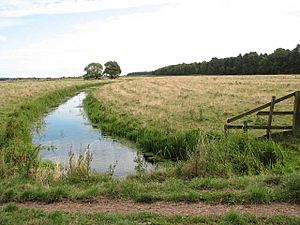Damgate Marshes, Acle facts for kids
| Site of Special Scientific Interest | |
 |
|
| Area of Search | Norfolk |
|---|---|
| Interest | Biological |
| Area | 64.7 hectares (160 acres) |
| Notification | 1993 |
| Location map | Magic Map |
Damgate Marshes, Acle is a really special place for nature in Norfolk, England. It's a large area of wetland, about 64.7 hectares (160 acres) (that's like 160 football fields!). This area is so important that it's been given a special title: a Site of Special Scientific Interest (SSSI). It's also part of an even bigger protected area called the Broadland Ramsar site and The Broads Special Area of Conservation. These titles mean it's a super important spot for wildlife, especially for its unique plants and tiny creatures that live in the water.
Contents
Discovering Damgate Marshes
Damgate Marshes is located between the towns of Norwich and Great Yarmouth in Norfolk. It's a wonderful example of a traditional wetland, which means it's a naturally wet area of land. For many years, this land has been used as "grazing marshes," where animals like cows would eat the grass. This traditional way of managing the land helps keep it healthy for all the different plants and animals that live there.
Why is Damgate Marshes Important?
The main reason Damgate Marshes is so special is because of its "dykes." These are like small, narrow canals or ditches that crisscross the marsh. These dykes are incredibly important for nature. They are home to many different kinds of water plants, some of which are quite rare and hard to find elsewhere.
Amazing Aquatic Life
Besides the plants, the dykes at Damgate Marshes are also buzzing with life! They have a huge variety of "aquatic invertebrates." These are small creatures without backbones that live in the water, like insects, snails, and worms. This wide range of tiny creatures shows how healthy the water and environment are. They are a vital part of the food chain for bigger animals like birds and fish.
Exploring the Marshes
If you want to visit Damgate Marshes and see some of this amazing nature for yourself, you can! The Weavers Way footpath goes right through the site. This path allows people to walk through the beautiful landscape and enjoy the peaceful surroundings, while also protecting the delicate wildlife. It's a great way to experience this nationally important wetland.

